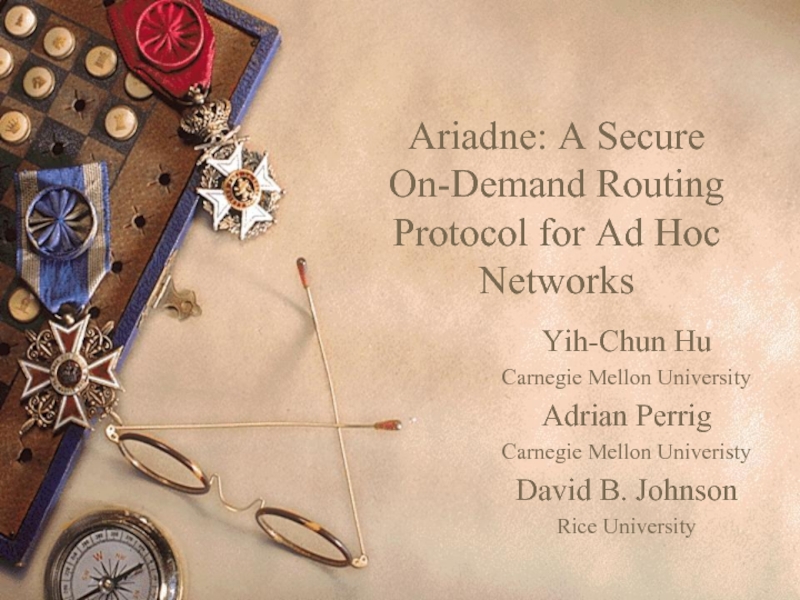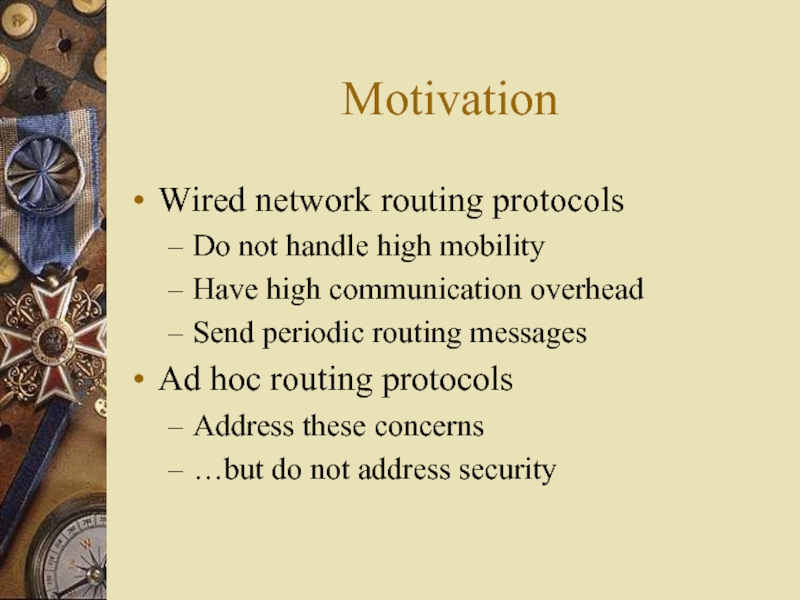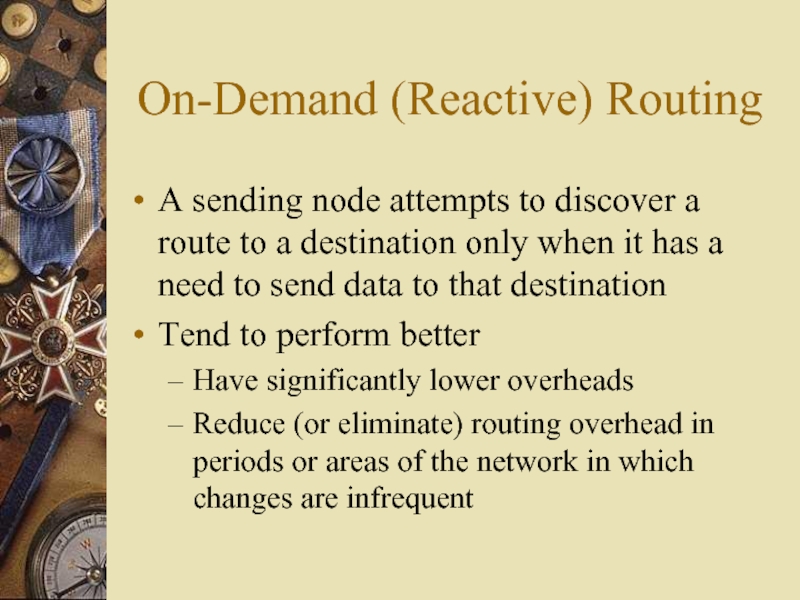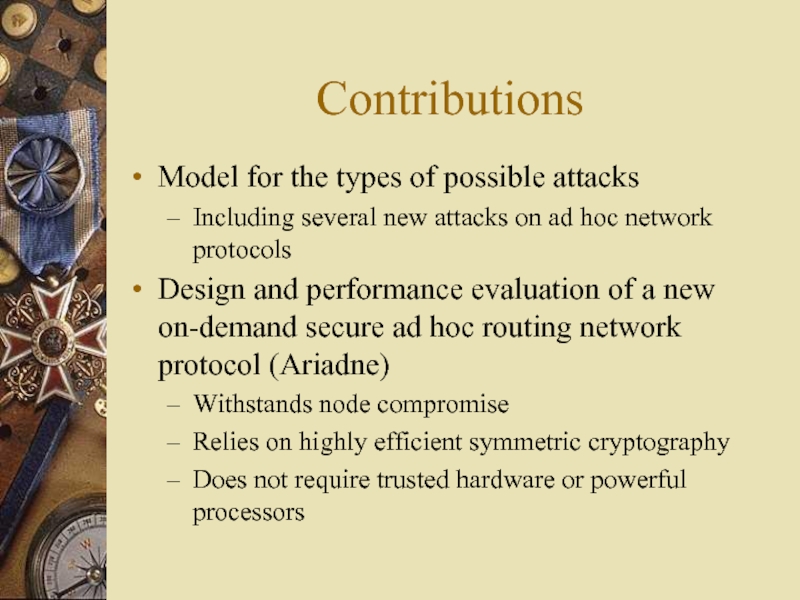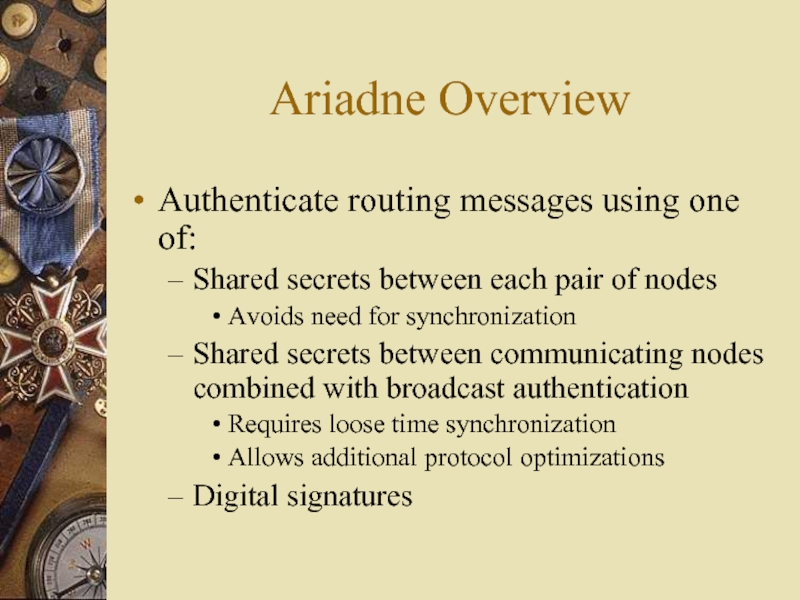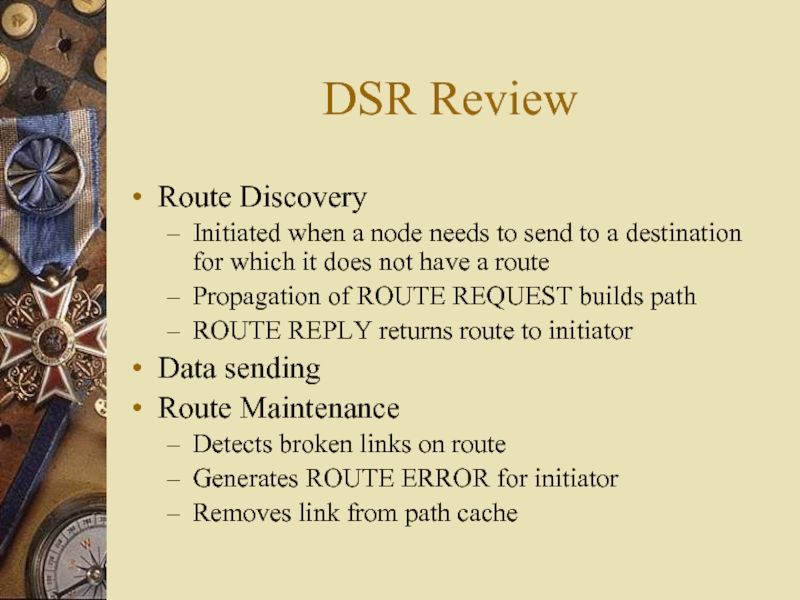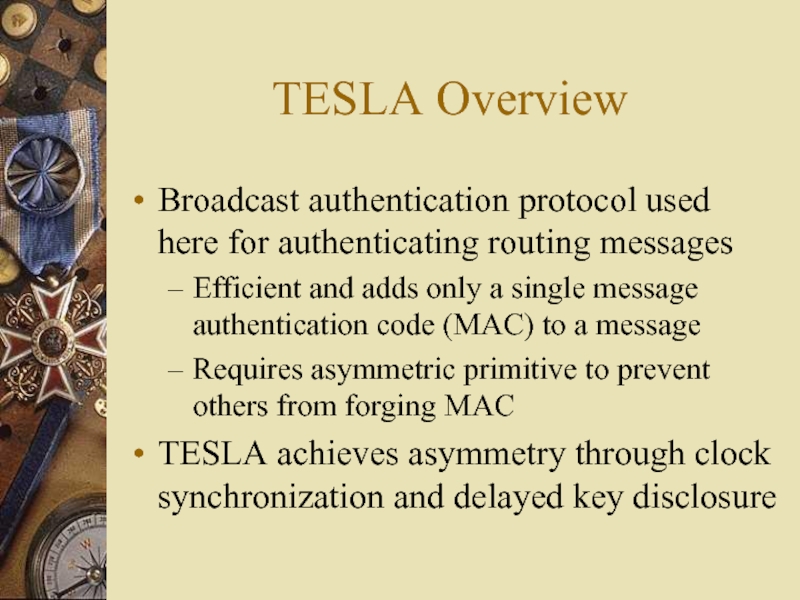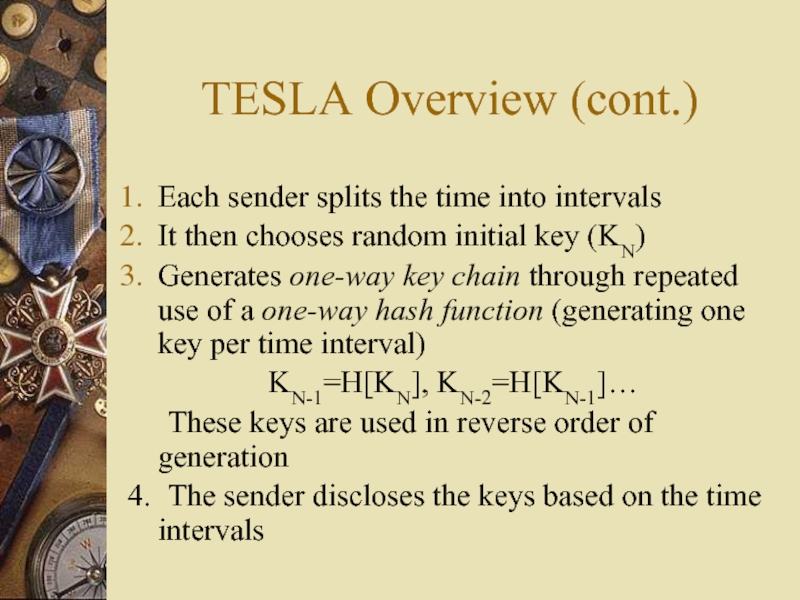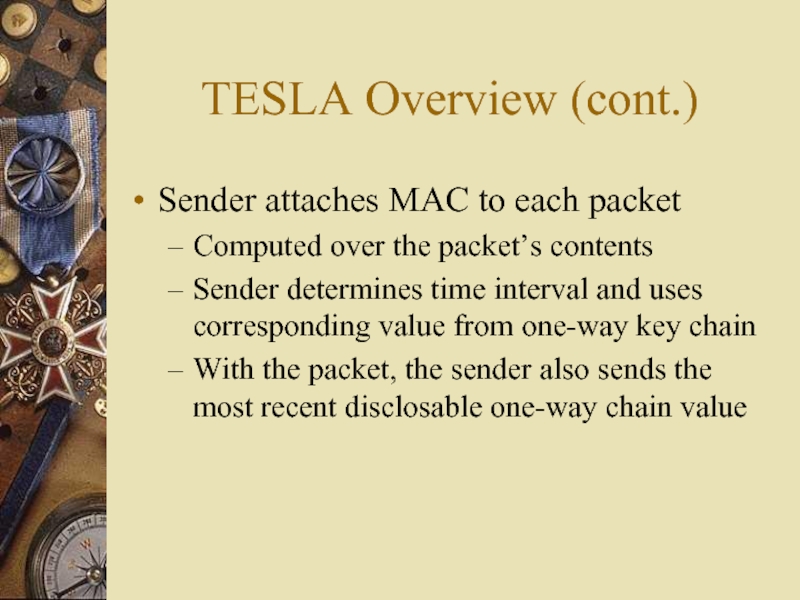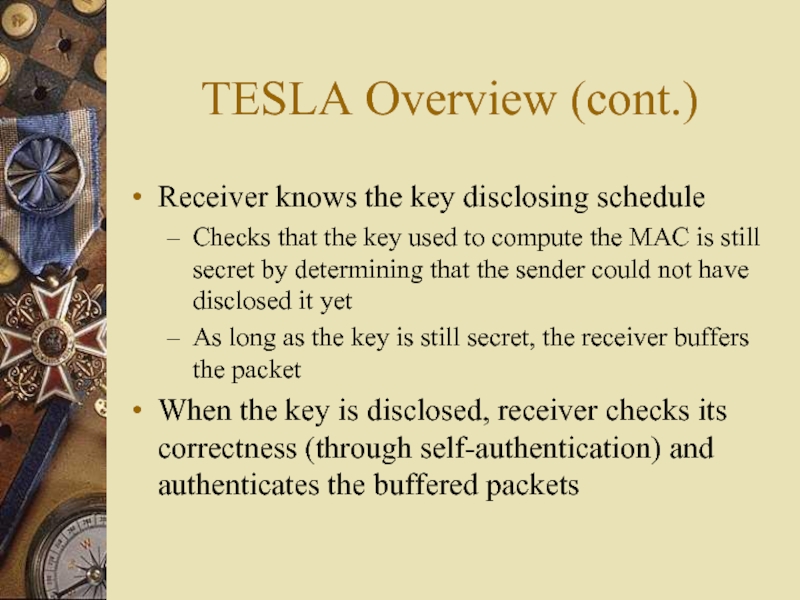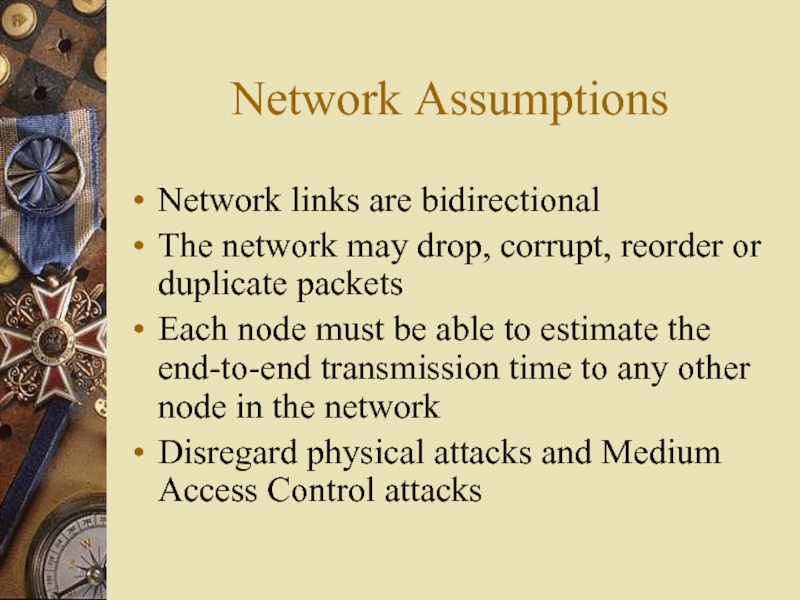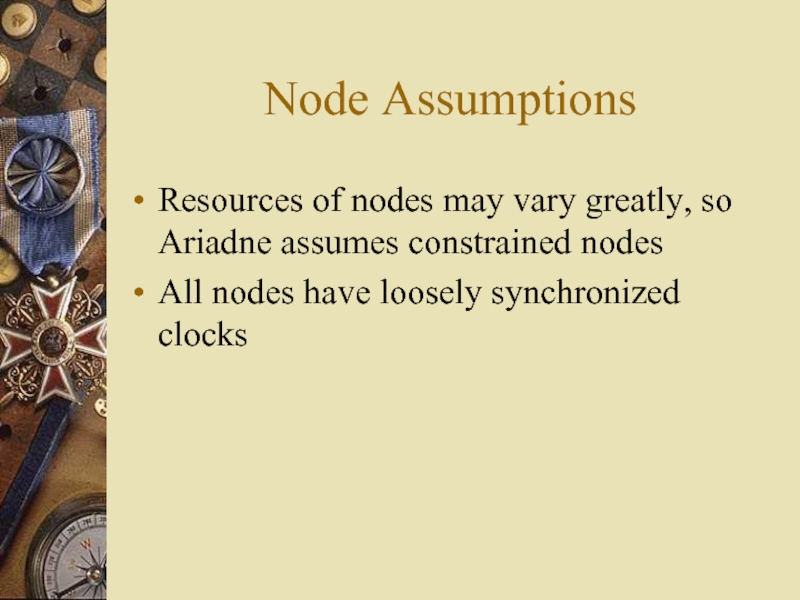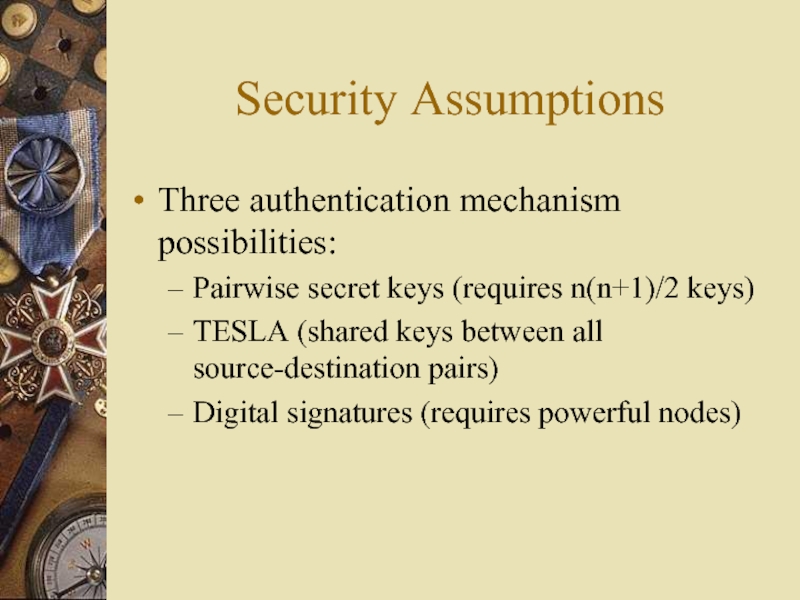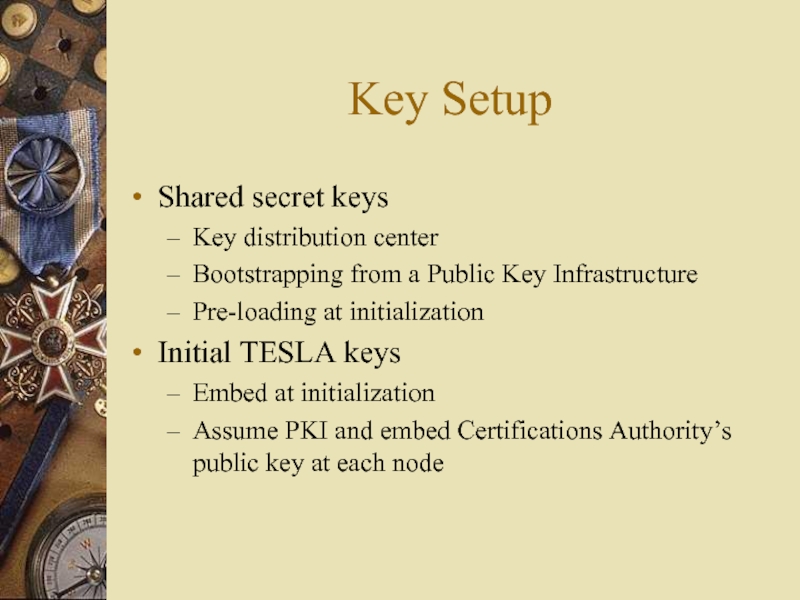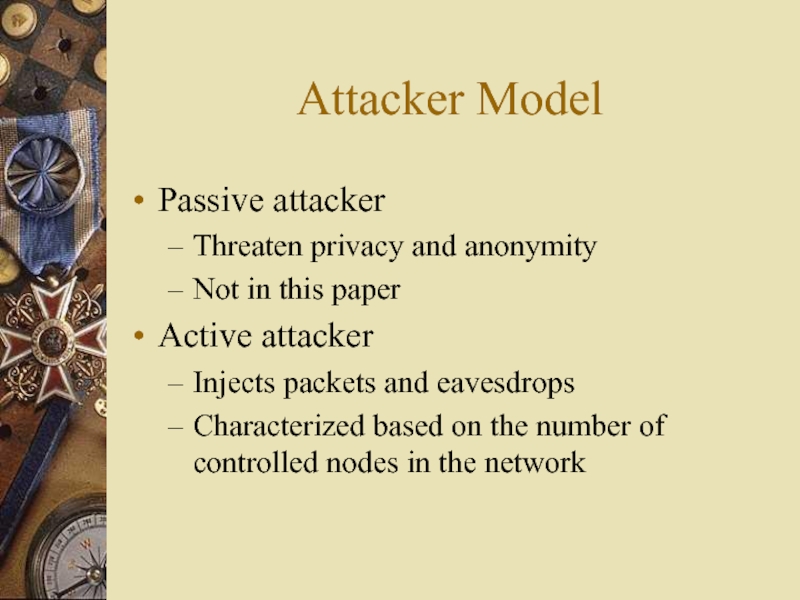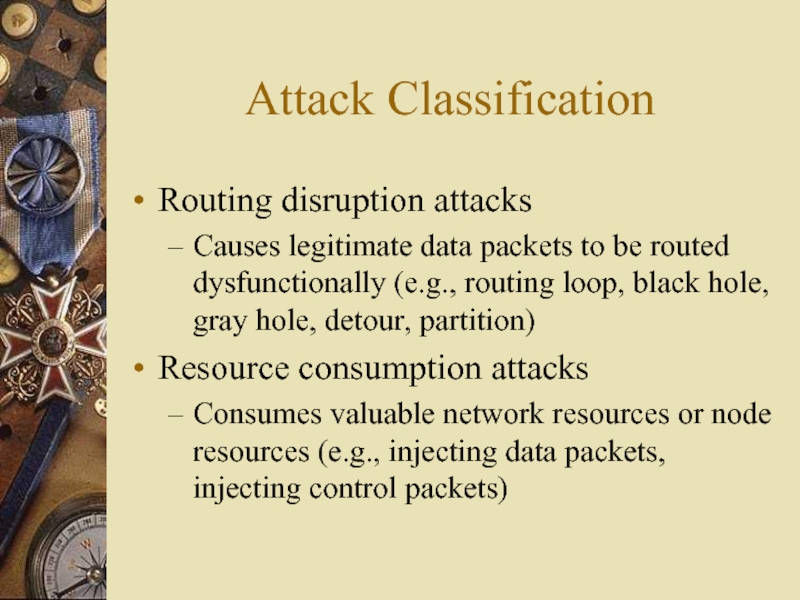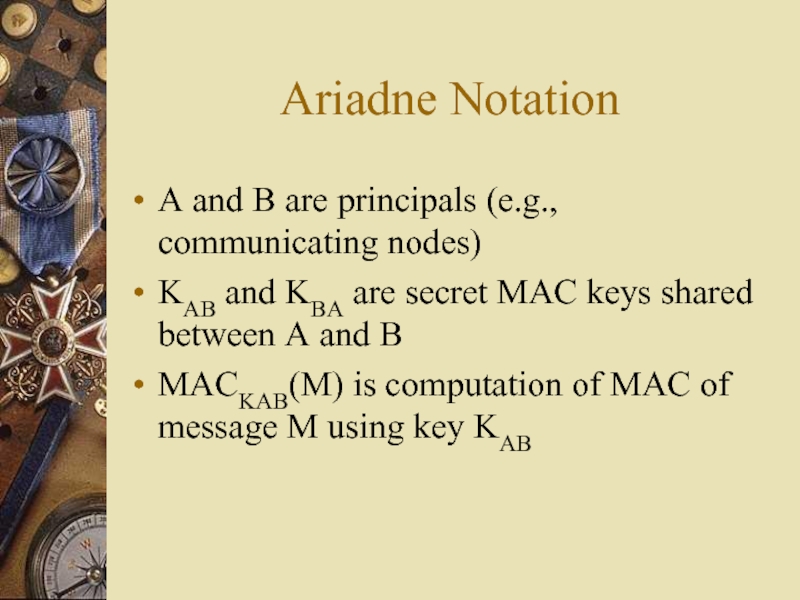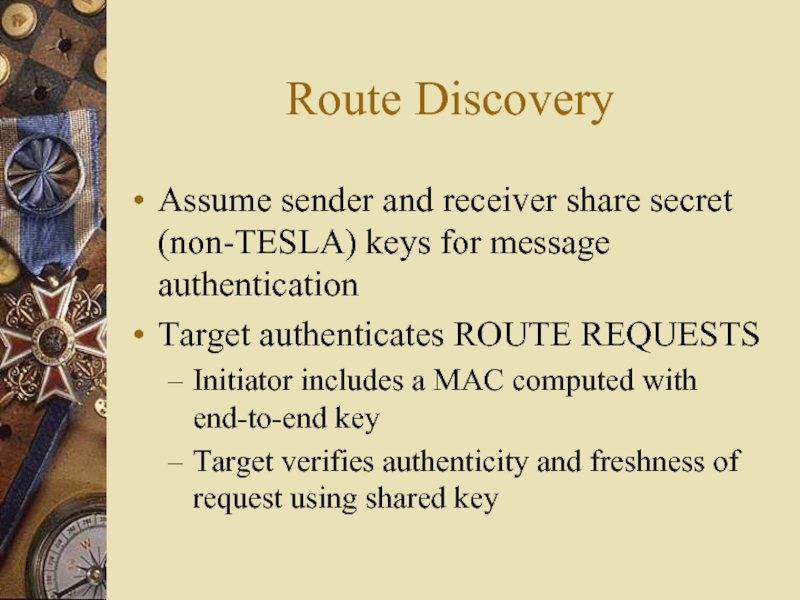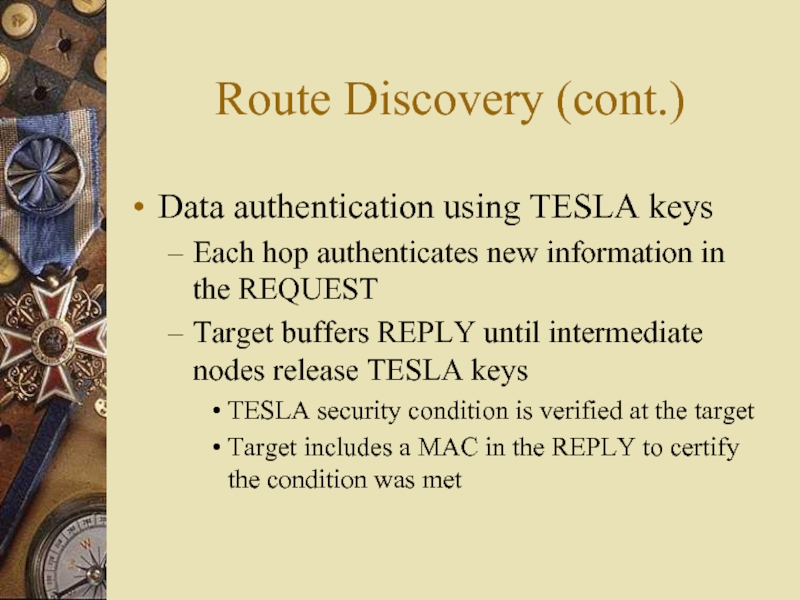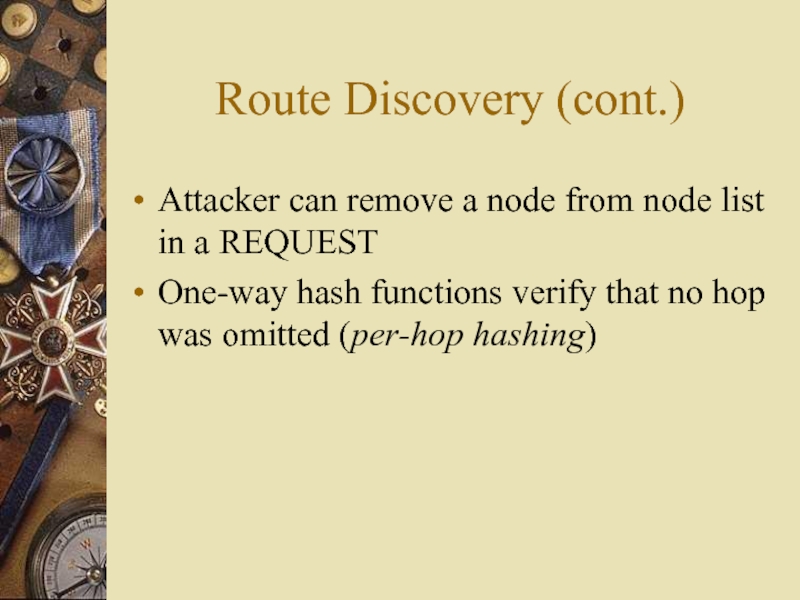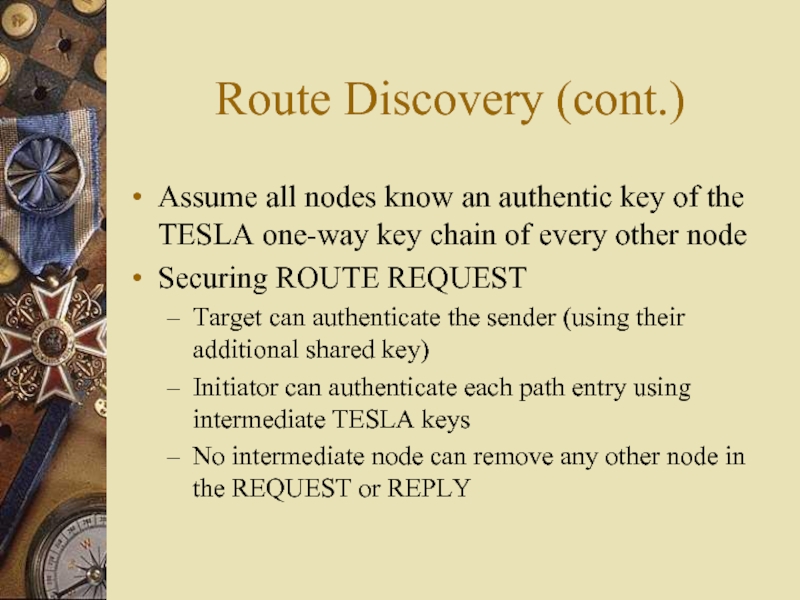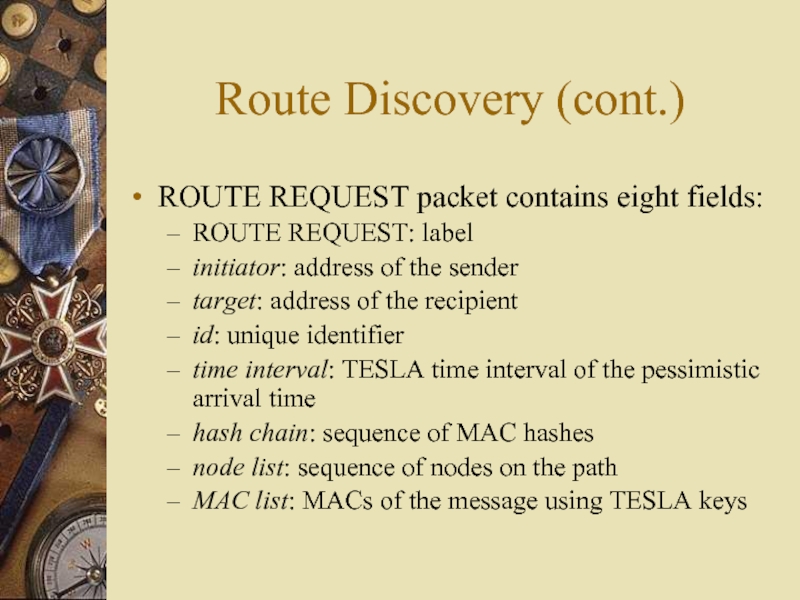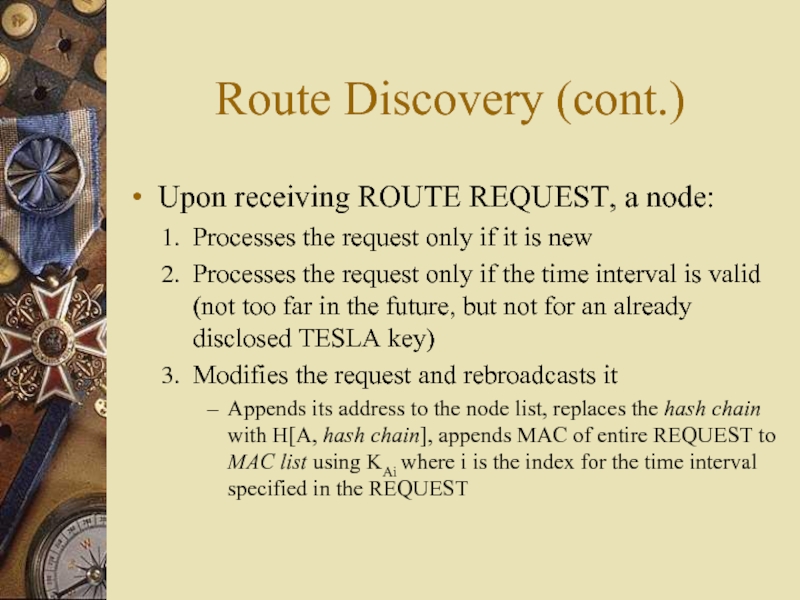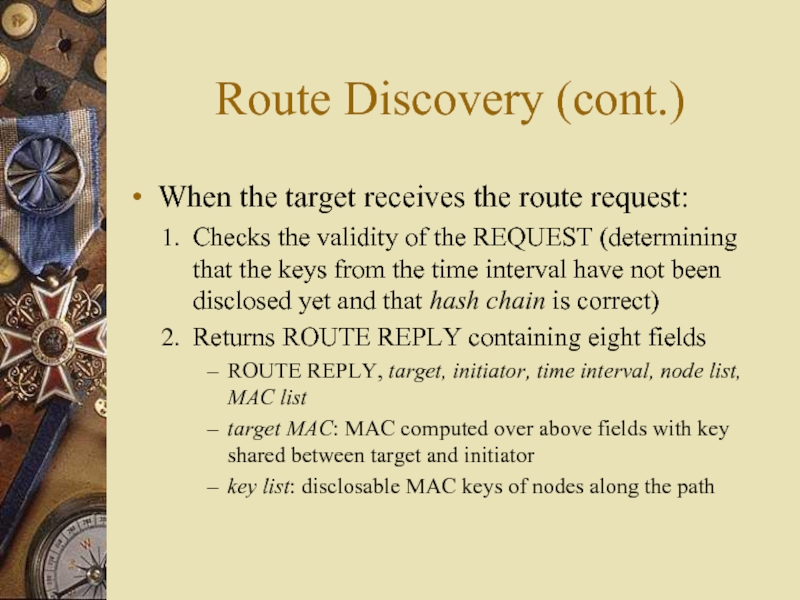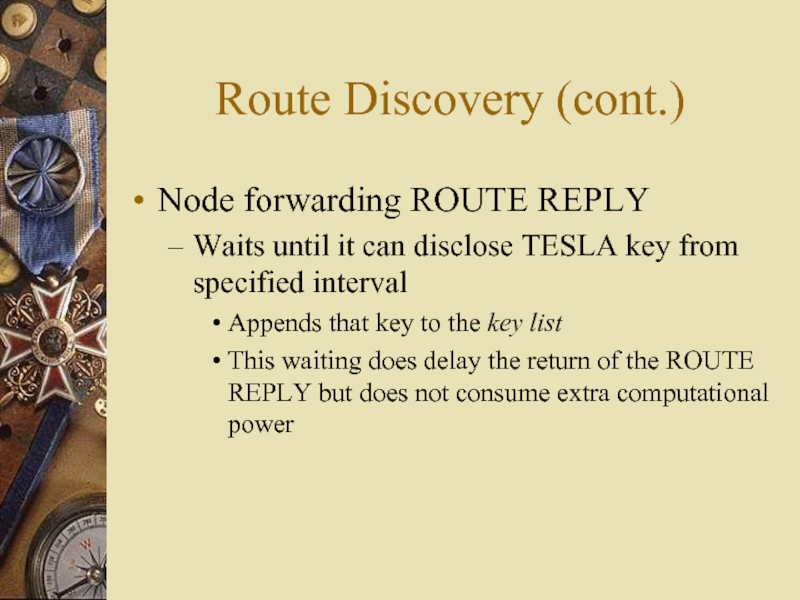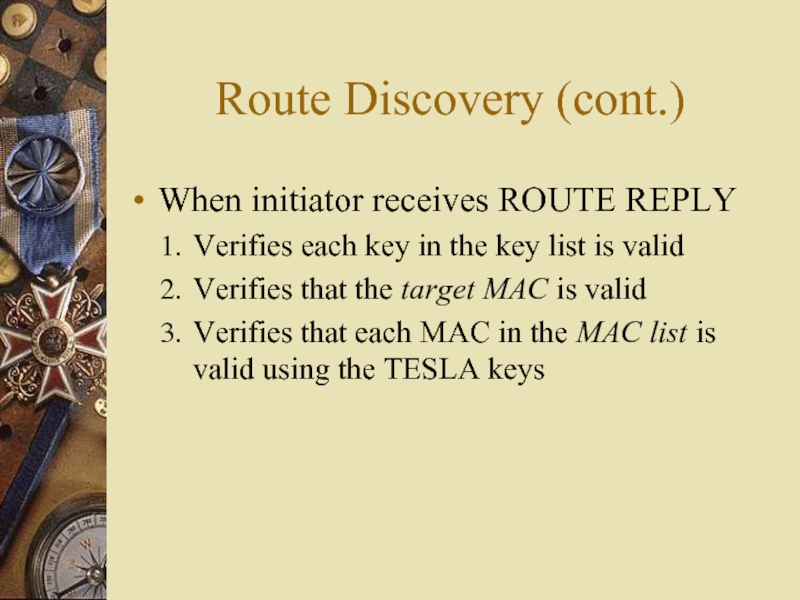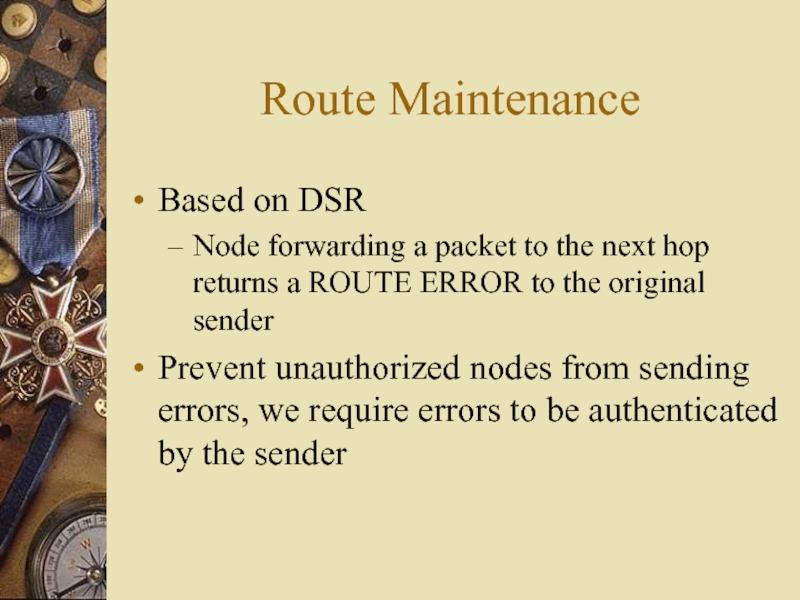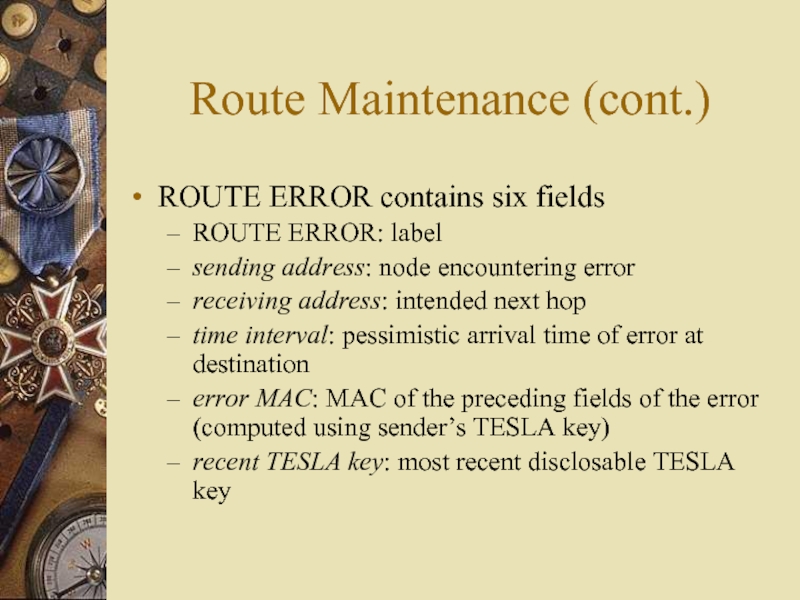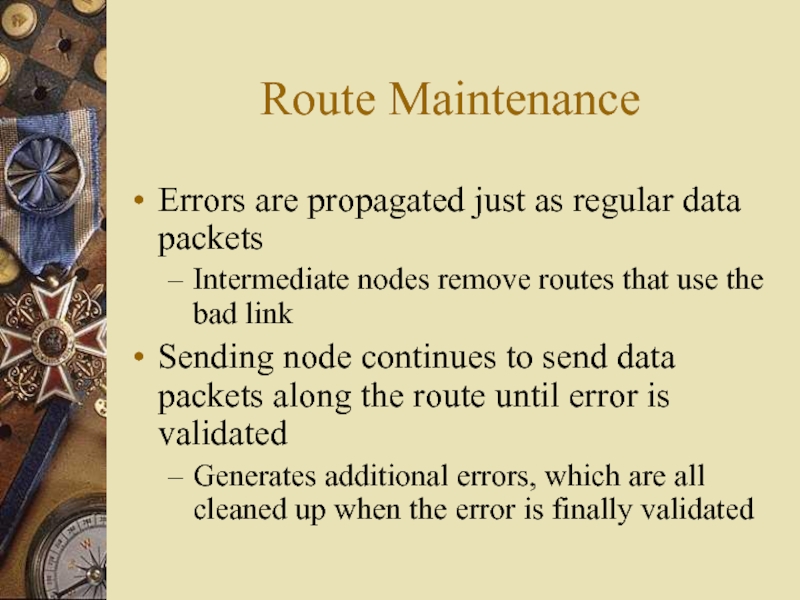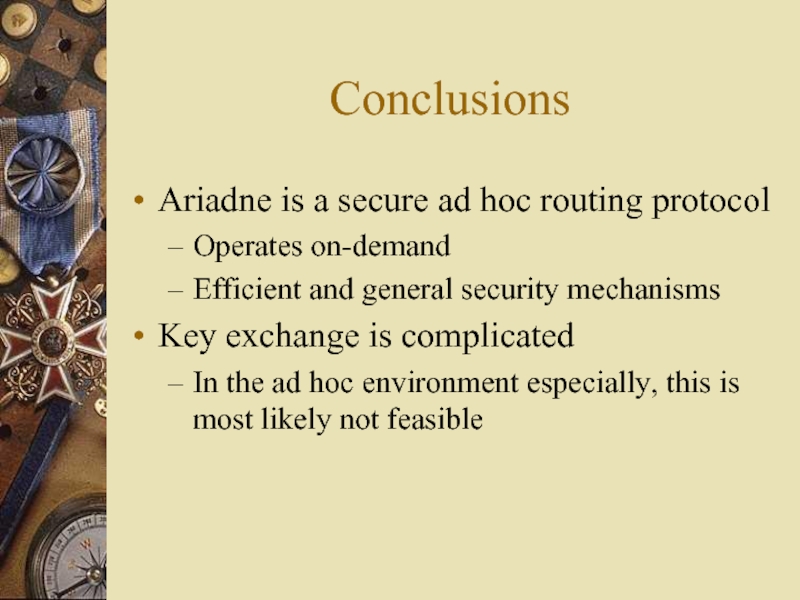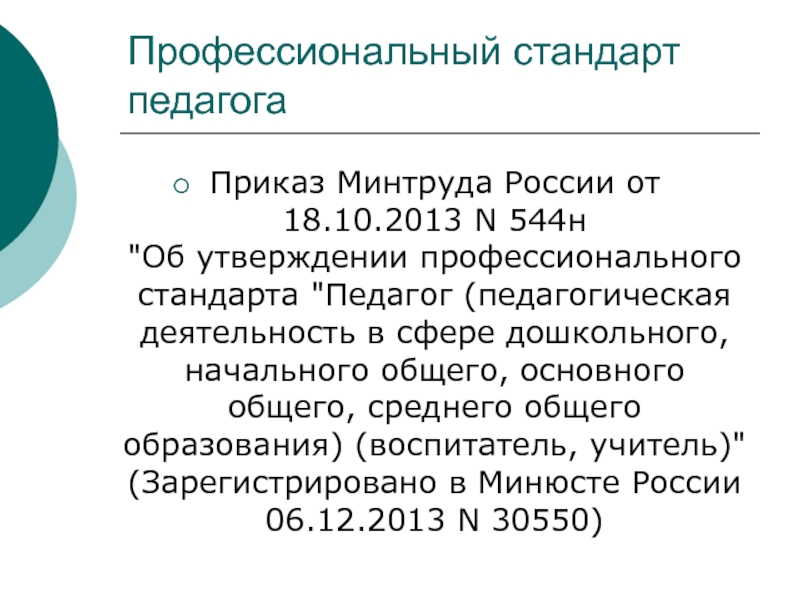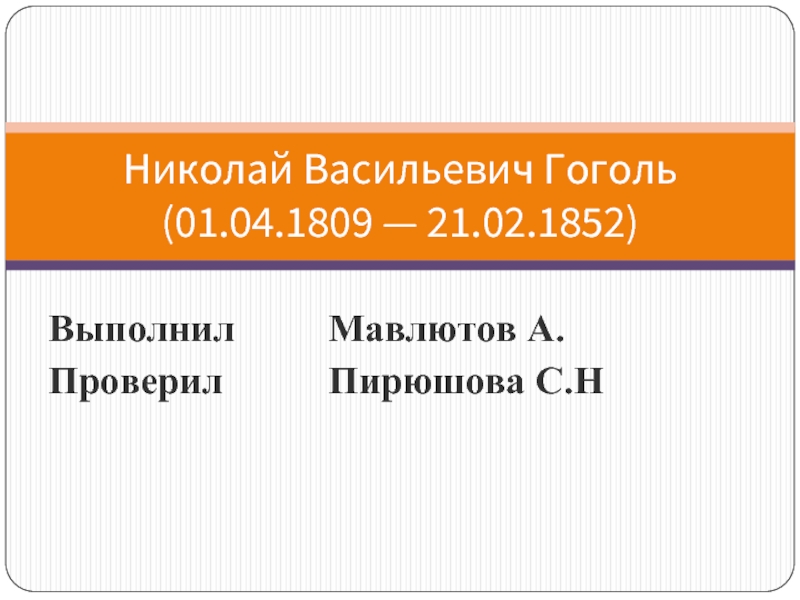Mellon University
Adrian Perrig
Carnegie Mellon Univeristy
David B. Johnson
Rice University
- Главная
- Разное
- Дизайн
- Бизнес и предпринимательство
- Аналитика
- Образование
- Развлечения
- Красота и здоровье
- Финансы
- Государство
- Путешествия
- Спорт
- Недвижимость
- Армия
- Графика
- Культурология
- Еда и кулинария
- Лингвистика
- Английский язык
- Астрономия
- Алгебра
- Биология
- География
- Детские презентации
- Информатика
- История
- Литература
- Маркетинг
- Математика
- Медицина
- Менеджмент
- Музыка
- МХК
- Немецкий язык
- ОБЖ
- Обществознание
- Окружающий мир
- Педагогика
- Русский язык
- Технология
- Физика
- Философия
- Химия
- Шаблоны, картинки для презентаций
- Экология
- Экономика
- Юриспруденция
Ariadne: A Secure On-Demand Routing Protocol for Ad Hoc Networks презентация
Содержание
- 1. Ariadne: A Secure On-Demand Routing Protocol for Ad Hoc Networks
- 2. Motivation Wired network routing protocols Do not
- 3. On-Demand (Reactive) Routing A sending node attempts
- 4. Contributions Model for the types of possible
- 5. Ariadne Overview Authenticate routing messages using one
- 6. DSR Review Route Discovery Initiated when a
- 7. TESLA Overview Broadcast authentication protocol used here
- 8. TESLA Overview (cont.) Each sender splits the
- 9. TESLA Overview (cont.) Sender attaches MAC to
- 10. TESLA Overview (cont.) Receiver knows the key
- 11. Network Assumptions Network links are bidirectional The
- 12. Node Assumptions Resources of nodes may vary
- 13. Security Assumptions Three authentication mechanism possibilities: Pairwise
- 14. Key Setup Shared secret keys Key distribution
- 15. Attacker Model Passive attacker Threaten privacy and
- 16. Attack Classification Routing disruption attacks Causes legitimate
- 17. Ariadne Notation A and B are principals
- 18. Route Discovery Assume sender and receiver share
- 19. Route Discovery (cont.) Data authentication using TESLA
- 20. Route Discovery (cont.) Attacker can remove a
- 21. Route Discovery (cont.) Assume all nodes know
- 22. Route Discovery (cont.) ROUTE REQUEST packet contains
- 23. Route Discovery (cont.) Upon receiving ROUTE REQUEST,
- 24. Route Discovery (cont.) When the target receives
- 25. Route Discovery (cont.) Node forwarding ROUTE REPLY
- 26. Route Discovery (cont.) When initiator receives ROUTE
- 27. Route Maintenance Based on DSR Node forwarding
- 28. Route Maintenance (cont.) ROUTE ERROR contains six
- 29. Route Maintenance Errors are propagated just as
- 30. Conclusions Ariadne is a secure ad hoc
Слайд 2Motivation
Wired network routing protocols
Do not handle high mobility
Have high communication overhead
Send
periodic routing messages
Ad hoc routing protocols
Address these concerns
…but do not address security
Ad hoc routing protocols
Address these concerns
…but do not address security
Слайд 3On-Demand (Reactive) Routing
A sending node attempts to discover a route to
a destination only when it has a need to send data to that destination
Tend to perform better
Have significantly lower overheads
Reduce (or eliminate) routing overhead in periods or areas of the network in which changes are infrequent
Tend to perform better
Have significantly lower overheads
Reduce (or eliminate) routing overhead in periods or areas of the network in which changes are infrequent
Слайд 4Contributions
Model for the types of possible attacks
Including several new attacks on
ad hoc network protocols
Design and performance evaluation of a new on-demand secure ad hoc routing network protocol (Ariadne)
Withstands node compromise
Relies on highly efficient symmetric cryptography
Does not require trusted hardware or powerful processors
Design and performance evaluation of a new on-demand secure ad hoc routing network protocol (Ariadne)
Withstands node compromise
Relies on highly efficient symmetric cryptography
Does not require trusted hardware or powerful processors
Слайд 5Ariadne Overview
Authenticate routing messages using one of:
Shared secrets between each pair
of nodes
Avoids need for synchronization
Shared secrets between communicating nodes combined with broadcast authentication
Requires loose time synchronization
Allows additional protocol optimizations
Digital signatures
Avoids need for synchronization
Shared secrets between communicating nodes combined with broadcast authentication
Requires loose time synchronization
Allows additional protocol optimizations
Digital signatures
Слайд 6DSR Review
Route Discovery
Initiated when a node needs to send to a
destination for which it does not have a route
Propagation of ROUTE REQUEST builds path
ROUTE REPLY returns route to initiator
Data sending
Route Maintenance
Detects broken links on route
Generates ROUTE ERROR for initiator
Removes link from path cache
Propagation of ROUTE REQUEST builds path
ROUTE REPLY returns route to initiator
Data sending
Route Maintenance
Detects broken links on route
Generates ROUTE ERROR for initiator
Removes link from path cache
Слайд 7TESLA Overview
Broadcast authentication protocol used here for authenticating routing messages
Efficient and
adds only a single message authentication code (MAC) to a message
Requires asymmetric primitive to prevent others from forging MAC
TESLA achieves asymmetry through clock synchronization and delayed key disclosure
Requires asymmetric primitive to prevent others from forging MAC
TESLA achieves asymmetry through clock synchronization and delayed key disclosure
Слайд 8TESLA Overview (cont.)
Each sender splits the time into intervals
It then chooses
random initial key (KN)
Generates one-way key chain through repeated use of a one-way hash function (generating one key per time interval)
KN-1=H[KN], KN-2=H[KN-1]…
These keys are used in reverse order of generation
4. The sender discloses the keys based on the time intervals
Generates one-way key chain through repeated use of a one-way hash function (generating one key per time interval)
KN-1=H[KN], KN-2=H[KN-1]…
These keys are used in reverse order of generation
4. The sender discloses the keys based on the time intervals
Слайд 9TESLA Overview (cont.)
Sender attaches MAC to each packet
Computed over the packet’s
contents
Sender determines time interval and uses corresponding value from one-way key chain
With the packet, the sender also sends the most recent disclosable one-way chain value
Sender determines time interval and uses corresponding value from one-way key chain
With the packet, the sender also sends the most recent disclosable one-way chain value
Слайд 10TESLA Overview (cont.)
Receiver knows the key disclosing schedule
Checks that the key
used to compute the MAC is still secret by determining that the sender could not have disclosed it yet
As long as the key is still secret, the receiver buffers the packet
When the key is disclosed, receiver checks its correctness (through self-authentication) and authenticates the buffered packets
As long as the key is still secret, the receiver buffers the packet
When the key is disclosed, receiver checks its correctness (through self-authentication) and authenticates the buffered packets
Слайд 11Network Assumptions
Network links are bidirectional
The network may drop, corrupt, reorder or
duplicate packets
Each node must be able to estimate the end-to-end transmission time to any other node in the network
Disregard physical attacks and Medium Access Control attacks
Each node must be able to estimate the end-to-end transmission time to any other node in the network
Disregard physical attacks and Medium Access Control attacks
Слайд 12Node Assumptions
Resources of nodes may vary greatly, so Ariadne assumes constrained
nodes
All nodes have loosely synchronized clocks
All nodes have loosely synchronized clocks
Слайд 13Security Assumptions
Three authentication mechanism possibilities:
Pairwise secret keys (requires n(n+1)/2 keys)
TESLA (shared
keys between all source-destination pairs)
Digital signatures (requires powerful nodes)
Digital signatures (requires powerful nodes)
Слайд 14Key Setup
Shared secret keys
Key distribution center
Bootstrapping from a Public Key Infrastructure
Pre-loading
at initialization
Initial TESLA keys
Embed at initialization
Assume PKI and embed Certifications Authority’s public key at each node
Initial TESLA keys
Embed at initialization
Assume PKI and embed Certifications Authority’s public key at each node
Слайд 15Attacker Model
Passive attacker
Threaten privacy and anonymity
Not in this paper
Active attacker
Injects packets
and eavesdrops
Characterized based on the number of controlled nodes in the network
Characterized based on the number of controlled nodes in the network
Слайд 16Attack Classification
Routing disruption attacks
Causes legitimate data packets to be routed dysfunctionally
(e.g., routing loop, black hole, gray hole, detour, partition)
Resource consumption attacks
Consumes valuable network resources or node resources (e.g., injecting data packets, injecting control packets)
Resource consumption attacks
Consumes valuable network resources or node resources (e.g., injecting data packets, injecting control packets)
Слайд 17Ariadne Notation
A and B are principals (e.g., communicating nodes)
KAB and KBA
are secret MAC keys shared between A and B
MACKAB(M) is computation of MAC of message M using key KAB
MACKAB(M) is computation of MAC of message M using key KAB
Слайд 18Route Discovery
Assume sender and receiver share secret (non-TESLA) keys for message
authentication
Target authenticates ROUTE REQUESTS
Initiator includes a MAC computed with end-to-end key
Target verifies authenticity and freshness of request using shared key
Target authenticates ROUTE REQUESTS
Initiator includes a MAC computed with end-to-end key
Target verifies authenticity and freshness of request using shared key
Слайд 19Route Discovery (cont.)
Data authentication using TESLA keys
Each hop authenticates new information
in the REQUEST
Target buffers REPLY until intermediate nodes release TESLA keys
TESLA security condition is verified at the target
Target includes a MAC in the REPLY to certify the condition was met
Target buffers REPLY until intermediate nodes release TESLA keys
TESLA security condition is verified at the target
Target includes a MAC in the REPLY to certify the condition was met
Слайд 20Route Discovery (cont.)
Attacker can remove a node from node list in
a REQUEST
One-way hash functions verify that no hop was omitted (per-hop hashing)
One-way hash functions verify that no hop was omitted (per-hop hashing)
Слайд 21Route Discovery (cont.)
Assume all nodes know an authentic key of the
TESLA one-way key chain of every other node
Securing ROUTE REQUEST
Target can authenticate the sender (using their additional shared key)
Initiator can authenticate each path entry using intermediate TESLA keys
No intermediate node can remove any other node in the REQUEST or REPLY
Securing ROUTE REQUEST
Target can authenticate the sender (using their additional shared key)
Initiator can authenticate each path entry using intermediate TESLA keys
No intermediate node can remove any other node in the REQUEST or REPLY
Слайд 22Route Discovery (cont.)
ROUTE REQUEST packet contains eight fields:
ROUTE REQUEST: label
initiator: address
of the sender
target: address of the recipient
id: unique identifier
time interval: TESLA time interval of the pessimistic arrival time
hash chain: sequence of MAC hashes
node list: sequence of nodes on the path
MAC list: MACs of the message using TESLA keys
target: address of the recipient
id: unique identifier
time interval: TESLA time interval of the pessimistic arrival time
hash chain: sequence of MAC hashes
node list: sequence of nodes on the path
MAC list: MACs of the message using TESLA keys
Слайд 23Route Discovery (cont.)
Upon receiving ROUTE REQUEST, a node:
Processes the request only
if it is new
Processes the request only if the time interval is valid (not too far in the future, but not for an already disclosed TESLA key)
Modifies the request and rebroadcasts it
Appends its address to the node list, replaces the hash chain with H[A, hash chain], appends MAC of entire REQUEST to MAC list using KAi where i is the index for the time interval specified in the REQUEST
Processes the request only if the time interval is valid (not too far in the future, but not for an already disclosed TESLA key)
Modifies the request and rebroadcasts it
Appends its address to the node list, replaces the hash chain with H[A, hash chain], appends MAC of entire REQUEST to MAC list using KAi where i is the index for the time interval specified in the REQUEST
Слайд 24Route Discovery (cont.)
When the target receives the route request:
Checks the validity
of the REQUEST (determining that the keys from the time interval have not been disclosed yet and that hash chain is correct)
Returns ROUTE REPLY containing eight fields
ROUTE REPLY, target, initiator, time interval, node list, MAC list
target MAC: MAC computed over above fields with key shared between target and initiator
key list: disclosable MAC keys of nodes along the path
Returns ROUTE REPLY containing eight fields
ROUTE REPLY, target, initiator, time interval, node list, MAC list
target MAC: MAC computed over above fields with key shared between target and initiator
key list: disclosable MAC keys of nodes along the path
Слайд 25Route Discovery (cont.)
Node forwarding ROUTE REPLY
Waits until it can disclose TESLA
key from specified interval
Appends that key to the key list
This waiting does delay the return of the ROUTE REPLY but does not consume extra computational power
Appends that key to the key list
This waiting does delay the return of the ROUTE REPLY but does not consume extra computational power
Слайд 26Route Discovery (cont.)
When initiator receives ROUTE REPLY
Verifies each key in the
key list is valid
Verifies that the target MAC is valid
Verifies that each MAC in the MAC list is valid using the TESLA keys
Verifies that the target MAC is valid
Verifies that each MAC in the MAC list is valid using the TESLA keys
Слайд 27Route Maintenance
Based on DSR
Node forwarding a packet to the next hop
returns a ROUTE ERROR to the original sender
Prevent unauthorized nodes from sending errors, we require errors to be authenticated by the sender
Prevent unauthorized nodes from sending errors, we require errors to be authenticated by the sender
Слайд 28Route Maintenance (cont.)
ROUTE ERROR contains six fields
ROUTE ERROR: label
sending address: node
encountering error
receiving address: intended next hop
time interval: pessimistic arrival time of error at destination
error MAC: MAC of the preceding fields of the error (computed using sender’s TESLA key)
recent TESLA key: most recent disclosable TESLA key
receiving address: intended next hop
time interval: pessimistic arrival time of error at destination
error MAC: MAC of the preceding fields of the error (computed using sender’s TESLA key)
recent TESLA key: most recent disclosable TESLA key
Слайд 29Route Maintenance
Errors are propagated just as regular data packets
Intermediate nodes remove
routes that use the bad link
Sending node continues to send data packets along the route until error is validated
Generates additional errors, which are all cleaned up when the error is finally validated
Sending node continues to send data packets along the route until error is validated
Generates additional errors, which are all cleaned up when the error is finally validated
Слайд 30Conclusions
Ariadne is a secure ad hoc routing protocol
Operates on-demand
Efficient and general
security mechanisms
Key exchange is complicated
In the ad hoc environment especially, this is most likely not feasible
Key exchange is complicated
In the ad hoc environment especially, this is most likely not feasible
